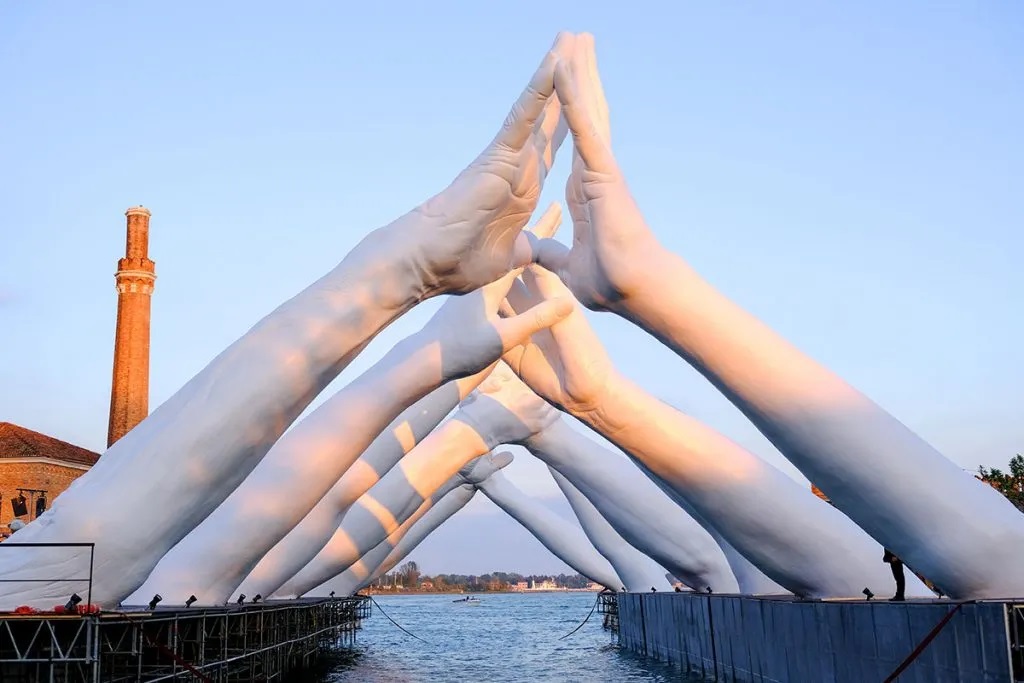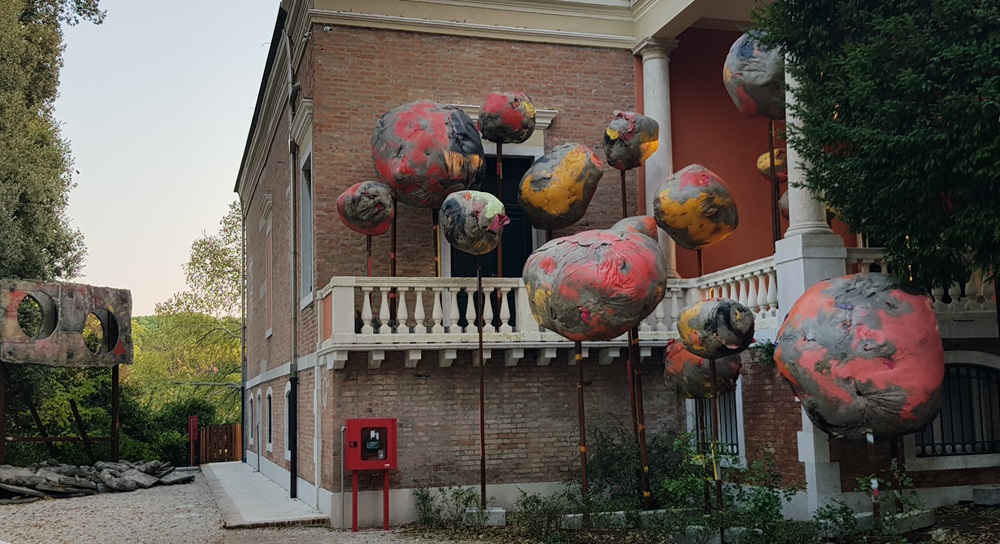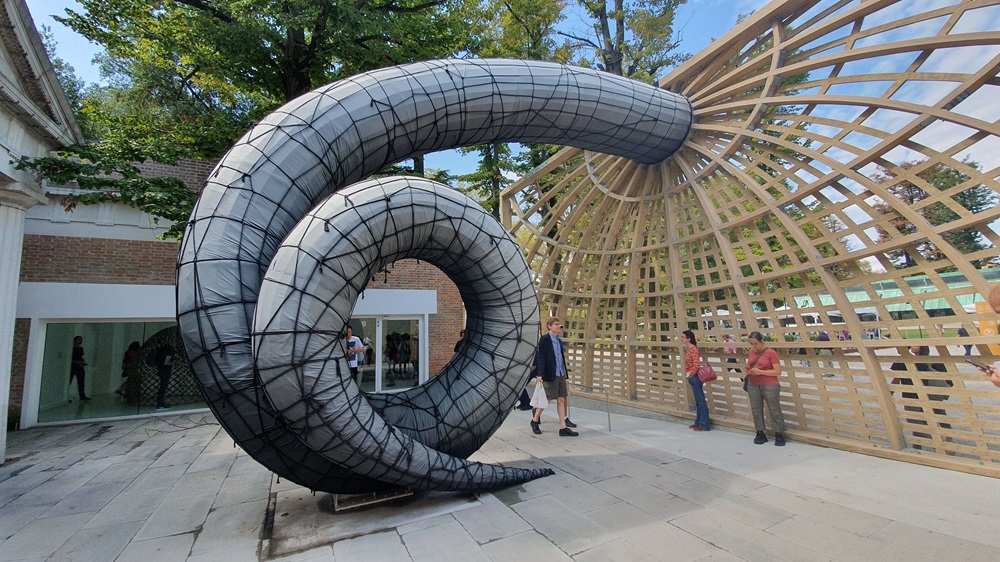In the enchanting embrace of Venice’s winding canals and timeless architecture, a flame of inspiration ignited within the hearts of its citizens. Mayor Riccardo Selvatico, a man enamoured with the arts, successfully persuaded the city council to embark on a grand endeavour – creating a Biennale celebrating Italy’s finest artistic talents. Initially scheduled for 1894, the event faced a minor delay, intensifying the anticipation. As the year rolled into 1895, Venice buzzed with excitement. Construction echoed through the Giardini di Castello as the magnificent Palazzo dell’Esposizione emerged, its neoclassical facade a testament to the city’s commitment to artistry.
The inaugural International Art Exhibition welcomed its first guests on a splendid April day. King Umberto I and Queen Margherita di Savoia of Italy graced the occasion, lending regal charm to the festivities. The doors swung open, and a wave of awe swept through the crowd as they beheld the masterpieces on display, crafted by local and foreign talents. The overwhelming success, drawing over 224,000 visitors, firmly established the Biennale as a premier artistic event.
The journey of artistic enlightenment continued to unfold. 1902, the Modern Art Gallery emerged as a beacon of contemporary expression, courtesy of Duchess Bevilacqua-La Masa’s generous patronage. Then, in 1907, a pivotal moment arrived with the unveiling of the first national pavilion, a breathtaking creation designed by a visionary Belgian architect. Thus began the tradition of countries crafting their own spaces within the Biennale, fostering a rich tapestry of international artistic exchange.

Despite the trials of the early 20th century, the spirit of creativity endured. In 1910, the Biennale witnessed the daring antics of Futurist poet Marinetti, whose playful rebellion sparked debate. Inside the exhibition halls, a wave of innovation swept through, with showcases dedicated to modern masters such as Klimt, Renoir, and Courbet. Yet, amidst the avant-garde surge, tensions between tradition and innovation simmered. Removing a provocative Picasso piece from the Spanish exhibition 1914 highlighted the delicate balance between pushing boundaries and respecting sensibilities. The addition of national pavilions, including the grand opening of the Russian pavilion in the same year, underscored the Biennale’s evolution into a global stage for artistic expression.
In 1922, bold choices such as the retrospective of Amedeo Modigliani alongside exhibitions of African sculptures challenged conventional tastes, leading to the establishment of an Administrative Board to oversee artistic selections. From the birth of the Venice Film Festival in 1932 to the emergence of the International Festival of Contemporary Music and the International Theatre Festival, the Biennale blossomed into a multifaceted celebration of the arts.
Even architecture played its part in the grand narrative, unveiling the Palazzo del Cinema and the Palazzo del Casinò on the Lido di Venezia, further enriching the city’s cultural tapestry.
Despite the shadows of World War II, the seeds of an international and diverse Biennale had been sown. The spirit of artistic expression endured, ensuring that the Venice Biennale would continue to enchant and inspire for generations to come. 1948, following the ravages of war and the fall of fascism, the International Art Exhibition reappeared, heralding a new era of creativity. Led by the visionary Rodolfo Pallucchini, the Biennale showcased a captivating array of artistic treasures, from the Impressionists to contemporary luminaries like Chagall and Picasso. Peggy Guggenheim’s famed collection found a home among these hallowed halls, enriching Venice’s cultural landscape.

As the years passed, the Biennale evolved, embracing new forms of artistic expression. In 1951, Akira Kurosawa’s “Rashomon” dazzled audiences, introducing Japanese cinema to the West and earning the coveted Golden Lion. The Premio Volpi honoured luminaries like Jean Gabin and Vivien Leigh, while the International Festival of Contemporary Music premiered Stravinsky’s masterpieces.
The 1950s saw the Biennale blossom further, with groundbreaking exhibitions and premieres. From Fellini’s “La Strada” to Visconti’s “Senso,” the Mostra del Cinema showcased cinematic marvels that captivated audiences worldwide. Music filled the air with the world premieres of Benjamin Britten’s “The Turn of the Screw” and Sergej Prokofiev’s “The Fiery Angel.” At the same time, the Art Exhibition celebrated avant-garde works by Braque, Matisse, and Calder. Yet, amid the celebration, challenges arose. Protests in 1957 led to institutional changes, reflecting the evolving social and political landscape. Student unrest in 1968 briefly disrupted the Biennale’s rhythm, but a renewed commitment to artistic freedom and expression emerged from the turmoil.
The 1970s brought further introspection and innovation. The International Art Exhibition embraced thematic exploration, while the Music Festival changed its scheduling. Though protests temporarily halted the award ceremonies, they resumed with renewed vigour, underscoring the Biennale’s enduring relevance. Through triumphs and tribulations, the Biennale symbolised Venice’s artistic soul. From the emergence of Pop Art in the 1960s to the recognition of global cinema in the 1970s, each moment was a testament to the enduring power of creativity and the enduring legacy of the Venice Biennale.
The year was 1977, when the world watched as the Biennale of Dissent, with its international and Soviet participation, stirred both acclaim and controversy. President Ripa di Meana, amidst the tumult, tendered his resignation, marking a pivotal moment in the Biennale’s history. As the years rolled by, each season he has had its tale. In 1978, the principle of permanent directors for each artistic sector was established, setting the stage for a new era of organization and creativity.
In architecture, Paolo Portoghesi’s vision breathed life into the Corderie dell’Arsenale, transforming it into a “Strada novissima” – a pathway to innovation and design. Meanwhile, the Golden Lion returned to honour cinematic excellence in cinema, bestowing its coveted award upon masterpieces like “Atlantic City” and “Gloria.” Amidst the artistic fervour, political statements echoed through the halls of the Biennale. In 1974, the call for “Freedom for Chile” rang out through theatre and cinema events, a testament to art’s power to provoke thought and inspire change. But it wasn’t just about the present; the Biennale had its sights set on the future. In 1990, the theme “Dimensione futuro” illuminated the path ahead, exploring the intersection of art and destiny.

As the Biennale approached its centenary in 1995, anticipation hung like a palpable force. Events unfolded across every sector, from the Festival del Teatro to the Mostra del Cinema, culminating in the historic exhibition “Identità e alterità.” Curated by Jean Clair, this showcase celebrated the human form in all its complexity, drawing together masterpieces from around the globe. 1999, a new dawn broke over the Biennale, breathing fresh life into its historical spaces at the Arsenale. The 48th International Art Exhibition, “APERTO Over All,” marked a turning point. It wasn’t merely about showcasing art anymore; a new sector emerged, DMT (Dance Music Theatre), bridging various artistic realms with live performances that mesmerized audiences.
As the millennium dawned in 2000, the Biennale paid homage to the Balkans in its Cinema sector while the Dance Music Theatre sectors pulsed with vibrant events. The Venice Film Festival, now in its 57th edition, honoured Clint Eastwood, a cinematic legend, with the Golden Lion for Lifetime Achievement, a fitting tribute to his enduring contributions.
The Biennale continued to evolve, embracing diverse forms of expression. In 2001, Shakespeare’s timeless tales took centre stage, captivating audiences worldwide. Meanwhile, the Dance Music Theatre sectors offered a mesmerizing array of performances, transcending borders and captivating hearts. In 2002, the Temps d’images festival ignited imaginations across Brussels, Paris, and Venice, exploring the intersection of live performance and visual media. The Venice Film Festival showcased international cinema’s best, while the International Architecture Exhibition pushed the boundaries of design and innovation.
By 2003, celebrating its 50th edition, the Biennale delved into the theme “Dreams and Conflicts – The Dictatorship of the Viewer,” inviting audiences to explore the intricate relationship between art and perception across various disciplines. In the following years, luminaries like Robert Storr and Rem Koolhaas guided the Biennale into uncharted territories of artistic exploration. Each edition pushed the boundaries of what art could be, captivating audiences and sparking meaningful dialogue.

In 2011, the Biennale unfolded with renewed vigour, drawing young minds into a world of imagination and discovery with the blossoming Kids’ Carnival. At the 54th International Art Exhibition, ILLUMInations illuminated the creative landscape, attracting a record-breaking number of visitors. As seasons turned, the 13th International Architecture Exhibition invited visitors to explore the shared essence of architectural marvels, while the 69th Venice Film Festival honoured storytelling with the prestigious Golden Lion award. 2014, the enchantment continued with the 5th International Kids’ Carnival, where laughter echoed through ancient halls. Meanwhile, the 14th International Architecture Exhibition, curated by Rem Koolhaas, captivated visitors, exploring the essence of architecture in depth.
In September, the 77th Venice International Film Festival unfolded against the Venetian skyline, a testament to cinema’s enduring spirit. Followed by the International Theatre Festival, the Festival of Contemporary Music, and the Festival of Contemporary Dance, each event revitalized the city’s cultural landscape. In 2020, amidst the bustling streets and vibrant piazzas, anticipation filled the air as preparations were underway for the International Kids’ Carnival. Little did they know, however, that soon after the festivities began, Italy and Europe would face an unprecedented challenge—the Covid-19 pandemic.
As the world grappled with uncertainty and lockdowns became the new reality, La Biennale di Venezia pivoted, embracing digital platforms to engage audiences with educational online activities. Plans for the 17th International Architecture Exhibition were postponed, and the anticipation deferred to when the world could gather safely again.
Yet, amidst the upheaval, glimpses of resilience emerged. The Theatre and Dance festivals found new dates in the latter half of the year, determined to carry on the tradition of showcasing the performing arts. Meanwhile, the Film and Music Festival stood firm in their original dates, offering moments of escape and inspiration in uncertain times. As the year drew to a close, new artistic directors were appointed, their vision poised to shape the next chapter of La Biennale di Venezia. With Alberto Barbera leading the way in cinema and a fresh lineup of talent in dance, music, and theatre, the stage was set for a future brimming with creativity and possibility. In the labyrinthine streets of Venice, where every corner holds a story and every canal whispers a secret, the Biennale stood as a beacon of hope—a testament to the enduring power of art to inspire, uplift, and unite us all.

Jain Syriac Babu is a Kerala-born, Italy-based theatre artist and art enthusiast.





